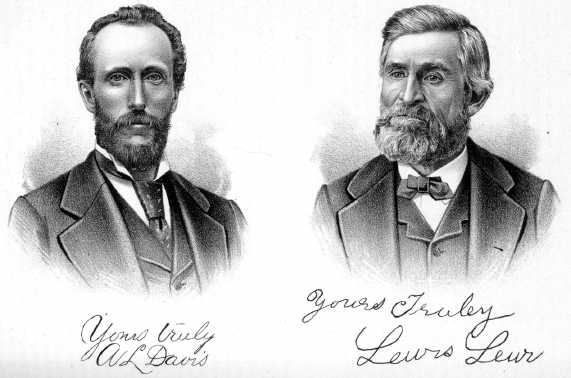his books and ambitious to excel. He
was graduated from Nebraska College in the class of
'83, taking special honors, and being the subject of
much favorable comment at the time. He served as
Notary Public in Nebraska City before reaching his
majority. He intends in the near future taking up the
study of law, which he has chosen for his life
profession. He has set out upon a most promising
career, one which will be watched with interest by
hosts of friends. He is the scion of an excellent
family, the members of which have distinguished
themselves in many of the public walks of life with
credit and fidelity. In the sketch of his brother,
Ezra T. Campbell, M. D., on another page in this
volume, is given a more extended history of the family
and its antecedents, which forms a most interesting
record.

 EWIS
LEWIS, whose portrait is given on an adjoining page,
is one of the earliest pioneers of Nebraska, is
numbered among its most honored citizens, and has seen
much of life in the Great West. He is a man very
highly esteemed by the people around him, one who is a
public-spirited citizen, always willing to lend a
helping hand in the carrying out of every project
tending to the good of the community. His excellent
partner, one who has stood by him through the storms
and sunshine of many year, is a lady who has proved
herself in every way suitable to be the companion of a
good man. They have a large family of handsome and
intelligent children, of whom they have reason to be
proud. EWIS
LEWIS, whose portrait is given on an adjoining page,
is one of the earliest pioneers of Nebraska, is
numbered among its most honored citizens, and has seen
much of life in the Great West. He is a man very
highly esteemed by the people around him, one who is a
public-spirited citizen, always willing to lend a
helping hand in the carrying out of every project
tending to the good of the community. His excellent
partner, one who has stood by him through the storms
and sunshine of many year, is a lady who has proved
herself in every way suitable to be the companion of a
good man. They have a large family of handsome and
intelligent children, of whom they have reason to be
proud.
The property of Mr. Lewis embraces
the southwest quarter of section 4, Otoe Precinct,
where he has lived and labored since 1862; he first
came to the precinct in April, 1855. He comes of
excellent Pennsylvania stock, being the son of Enos
and Elizabeth (Pinnell) Lewis, who were natives of
Delaware County, that State, the father born on the
very farm where the English Army was centered when
Washington was at Valley Forge. Grandfather Lewis had
purchased this from William Penn during the first
settlement of Pennsylvania. They were Quakers in
religion, and Enos Lewis traced his ancestry back to
the early Colonial days, when his progenitors crossed
the Atlantic from England and settled in
Pennsylvania.
The father of our subject was a
farmer by occupation, spent his entire life in his
native county, and died there in 1833. The mother of
our subject had been married first to a Mr. Burns, but
of this union there were no children. Of her marriage
with Enos Lewis there were born three sons and three
daughters, the eldest of whom, Wayne, was killed by
being thrown from a rig when one year old. The next
son, Henry, is a resident of Cloud County, Kan.; he
married Miss Isabelle Frost, and is the father of
seven children, namely: Henry D., Ida M., Ernest,
Alfred B., John W., Edith and Wilbur, Mary, Mrs.
Jackson LaTier, is a resident of Taylor County, Iowa;
Esther, Mrs. John W. White, resides in West Chester,
Chester Co., Pa.; Elizabeth, Mrs. Booze, a widow, is a
resident of Philadelphia, Pa., and the mother of three
children -- Henry, Albert and Lilly.
The subject of this sketch was the
fifth child of his parents, and was born on the old
homestead, the birthplace of his father, in Delaware
County, Pa., Sept. 20, 1831. He was but two years of
age at the time of his father's death, and resided
with his mother two years, then went to live with his
aunt, Mrs. Esther Garrett, of East Goshen Township,
Chester Co., Pa. He continued with her until a lad of
twelve years, but lived under the same roof until
sixteen. His education during those years was carried
on principally three months during the winter season,
but later he entered Greenwood Dell Academy, where he
studied one year, and afterward attended Unionville
Academy for eighteen months. In the meantime he worked
two and a half years on a farm.
In the spring of 1853 our subject
set out for the West, and traveled extensively through
Illinois, Indiana and Ohio. Later he returned to
Philadelphia, Pa., but could not content himself in
that region, and started once more for the West. In
the fall of 1853 he went to Jackson County, Mo., and
in May, 1854, started East, finally landing in
Pennsylvania, in August. Mr. Lewis, no more satisfied
than he had been before, after returning home, finally
made one desperate effort, starting out the
|


